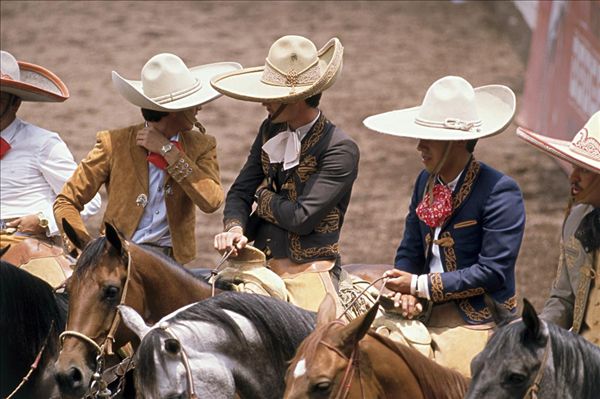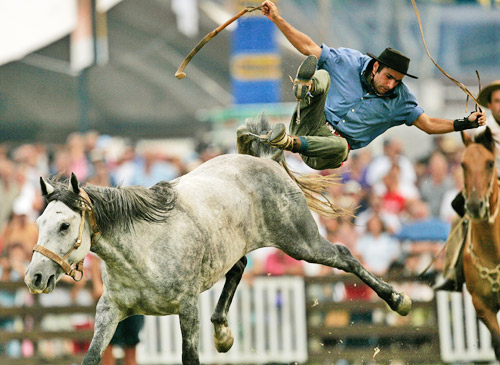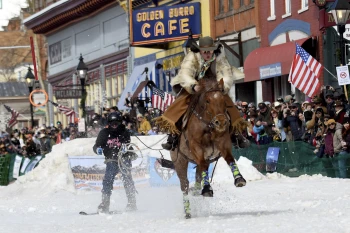The crisp winter air in Leadville, Colorado, carries with it the palpable excitement of an unconventional sport that defies gravity and convention.
As Nick Burri clicks into his ski bindings and prepares to embark on a thrilling ride, it is not just his skill and courage that propel him forward, but the sheer force of a quarter horse named Sirius.
This is skijoring, a unique and exhilarating winter sport that marries the rugged spirit of rodeo with the grace and agility of skiing in the majestic landscape of the U.S. Mountain West.
In skijoring, participants experience a heart-pounding rush as they are towed by horses, dogs, snowmobiles, or even cars at breakneck speeds exceeding 40 mph over challenging terrain littered with obstacles and jumps reaching heights of up to 8 feet.
The objective? To navigate the course with precision, aiming to spear suspended hoops with a baton, typically a ski pole halved for the purpose.
It is a spectacle that captivates thousands of spectators who flock to Leadville, a historic mining town nestled in the Rocky Mountains at an elevation of 10,158 feet, to witness one of the most renowned skijoring races in the nation.
The roots of skijoring trace back to Scandinavia, where it originated as a practical means of transportation before gaining popularity in the Alpine regions around 1900.
Over the years, the sport has evolved into a high-octane display of skill, daring, and camaraderie, attracting thrill-seekers and adventurers from far and wide.
The annual event in Leadville, known as “The Granddaddy of ’em All,” has been a cherished tradition since 1949, drawing participants and spectators alike to celebrate the fusion of two seemingly disparate worlds—skiing and horse riding.
For athletes like Burri, the allure of skijoring lies in the raw adrenaline that courses through their veins as they hurtle down the course, defying gravity and pushing the limits of their abilities.
The sport not only demands physical prowess and mental fortitude but also fosters a sense of unity among participants from diverse backgrounds, bridging the gap between riders and skiers who may not typically interact.
However, beneath the thrill and excitement of skijoring lurks an inherent danger that adds an element of unpredictability to the sport.
Injuries are not uncommon, with riders and skiers alike risking falls, collisions, and mishaps that can result in serious consequences.

The recent incident at the Leadville race serves as a stark reminder of the perils that accompany this high-speed pursuit, where split-second decisions can mean the difference between triumph and disaster.
Despite the risks, skijoring endures as a testament to the indomitable spirit of those who dare to embrace its challenges and revel in its exhilarating moments.
It embodies a blend of tradition, innovation, and sheer audacity that captivates both participants and spectators, forging bonds and memories that endure long after the snow has melted.
As the sun sets on another exhilarating day of skijoring in Leadville, one thing remains certain: the spirit of adventure and camaraderie that defines this extraordinary sport will continue to captivate hearts and minds, inspiring generations to come to push the boundaries of what is possible in the exhilarating world of skijoring.
Skijoring, a unique and exhilarating sport that combines skiing with horseback riding, has captured the hearts of adrenaline junkies and outdoor enthusiasts alike.
As described by enthusiasts like Burri, Decker, McCarthy, and Zhimanskova, skijoring is a thrilling blend of speed, skill, and camaraderie that keeps participants coming back for more, despite the inherent risks involved.
The adrenaline rush of hurtling down a snow-covered course while being pulled by a galloping horse is a sensation like no other.
The speed, the crashes, the raucous crowd cheering on the competitors—all these elements contribute to the allure of skijoring.
For riders like Decker and McCarthy, the moments of fear and excitement before a race are quickly replaced by a singular focus once they’re in motion.
The deafening silence of the moment, the intense concentration required to navigate the course, and the sheer exhilaration of the experience are what make skijoring truly unforgettable.
However, with the thrill of the sport also comes the inherent dangers. Broken bones, collisions, and unexpected mishaps are all part and parcel of skijoring.
McCarthy’s broken nose and Decker’s collarbone injury serve as stark reminders of the risks involved in this high-speed, high-stakes sport.
Yet, for these athletes, the adrenaline rush and the sense of accomplishment that comes with conquering these challenges outweigh the potential dangers.
Despite its growing popularity and dedicated fan base, skijoring faces hurdles in its quest for Olympic recognition.
The lack of a unified governing body, standardized rules, and a point system for advancement pose significant challenges to the sport’s inclusion in the Winter Games.
Each race is unique, with its own set of traditions and organizers, making it difficult to establish a cohesive framework for competition.
Nevertheless, advocates like Zhimanskova are determined to see skijoring on the world stage. With the sport gaining traction on social media and drawing large crowds at events across the country, there is a growing momentum behind the push for Olympic recognition.
The dream of seeing skijoring featured in the Winter Olympics is not far-fetched, as evidenced by the sport’s popularity in countries like Poland and Switzerland, as well as in states like Colorado, Wyoming, and Montana.
As skijoring continues to evolve and attract a wider audience, the prospect of Olympic inclusion remains a tantalizing possibility.

The visual spectacle of horses racing through the snow, skiers navigating treacherous courses, and the festive atmosphere of skijoring events all contribute to the sport’s unique appeal.
With advocates like Zhimanskova leading the charge, the future looks bright for skijoring as it strives to earn its place among the elite winter sports on the global stage.
In conclusion, skijoring embodies the perfect blend of speed, skill, and spectacle that captivates both participants and spectators alike.
Despite the risks and challenges that come with the sport, the thrill of skijoring continues to draw in new enthusiasts and push the boundaries of what is possible on snow and ice.
With its growing popularity and dedicated community of riders and skiers, skijoring stands poised to make a splash on the international stage, bringing its unique brand of excitement and camaraderie to audiences around the world.
